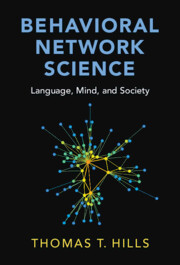Book contents
- Frontmatter
- Contents
- Additional Resources
- Introduction: Structure Matters
- Part I A Brief Guide to Network Science
- Part II Language
- Part III Mind
- Part IV Society
- 14 Network Illusions: How Structure Misleads Us
- 15 Group Problem Solving: Harnessing the Wisdom of the Crowds
- 16 The Segregation of Belief: How Structure Facilitates False Consensus
- 17 The Conspiracy Frame: Coherence through Self-Supporting Beliefs
- 18 The Kennedy Paradox: Games of Conflict and Escalation
- 19 Fund People Not Projects: A Universal Basic Income for Research
- References
- Index
15 - Group Problem Solving: Harnessing the Wisdom of the Crowds
from Part IV - Society
Published online by Cambridge University Press: 08 November 2024
- Frontmatter
- Contents
- Additional Resources
- Introduction: Structure Matters
- Part I A Brief Guide to Network Science
- Part II Language
- Part III Mind
- Part IV Society
- 14 Network Illusions: How Structure Misleads Us
- 15 Group Problem Solving: Harnessing the Wisdom of the Crowds
- 16 The Segregation of Belief: How Structure Facilitates False Consensus
- 17 The Conspiracy Frame: Coherence through Self-Supporting Beliefs
- 18 The Kennedy Paradox: Games of Conflict and Escalation
- 19 Fund People Not Projects: A Universal Basic Income for Research
- References
- Index
Summary
How can groups best coordinate to solve problems? The answer touches on cultural innovation, including the trajectory of science, technology, and art. If everyone acts independently, different people will explore different solutions, but there is no way to leverage good solutions across the community. If everyone acts in consort, early successes can lead the group down dead ends and stifle exploration. The challenge is one of maintaining innovation but also communicating effective solutions once they are found. When solutions spaces are smooth – that is, easy – communication is good. But when solution spaces are rugged – that is, hard – the balance should tilt toward exploration. How can we best achieve this? One answer is to place people in social structures that reduce communication, but maintain connectivity. But there are other solutions that might work better. Algorithms, like simulated annealing, are designed to deal with such problems by adjusting collective focus over time, allowing systems to “cool off” slowly as they home in on solutions. Network science allows us to explore the performance of such solutions on smooth and rugged landscapes, and provides numerous avenues for innovation of its own.
Keywords
- Type
- Chapter
- Information
- Behavioral Network ScienceLanguage, Mind, and Society, pp. 244 - 257Publisher: Cambridge University PressPrint publication year: 2024

